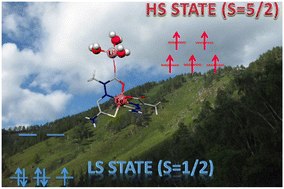First crystal structure of an Fe(iii) anionic complex based on a pyruvic acid thiosemicarbazone ligand with Li+: synthesis, features of magnetic behavior and theoretical analysis†
Abstract
The iron(III) anionic complex based on a pyruvic acid thiosemicarbazone ligand with the lithium cation Li[FeIII(thpy)2]·3H2O (1) has been synthesized and characterized by FTIR spectroscopy, powder and single crystal X-ray diffraction, direct current magnetic susceptibility measurements, and 57Fe Mössbauer spectroscopy. Moreover, the molecular structure of the [Fe(thpy)2]− anion has been determined for the first time. The [Fe(thpy)2]− units in the triclinic P![[1 with combining macron]](https://www.rsc.org/images/entities/char_0031_0304.gif) lattice of 1 are assembled into layers parallel to the bc plane. The Li+ cations and water molecules are located between the layers and the structure is stabilized by hydrogen bonding. The [Fe(thpy)2]− anions form interconnected dimer pairs through hydrogen bonds and short contacts with Fe⋯Fe separation of 6.7861(4) Å. According to dc magnetic measurements, compound 1 demonstrates an incipient spin-crossover transition from the LS (S = 1/2) to the HS (S = 5/2) state above 250 K. The Bleaney–Bowers equation for a model of an isolated LS dimer with a mean-field correction was applied to fit the experimental data of magnetic susceptibility dependence on temperature in the temperature range of 2–250 K. The intra-dimer J1 = −1.79(1) K and inter-dimer J2 = −0.24(3) K antiferromagnetic coupling constants were defined. The analysis of the 57Fe Mössbauer spectra at 80 K and 296 K confirms the presence of the shortened distances between the iron nuclei. Moreover, the influence of the lithium cation on the stabilization of the LS state was shown for the [Fe(thpy)2]− anion. BS-DFT calculations for the optimized structure of two isolated [Fe(thpy)2]− anions also correctly predict a weak exchange J1(calc) = −0.92 K. DFT calculations revealed the OPBE (GGA-type) functional that correctly predicts the spin-crossover transition for the iron(III) thpy compounds. Besides, the effect of the N2O4, N2S2O2, and N2Se2O2 coordination environments on the energy stabilization of the LS state of iron(III) anionic thpy complexes was noted as well.
lattice of 1 are assembled into layers parallel to the bc plane. The Li+ cations and water molecules are located between the layers and the structure is stabilized by hydrogen bonding. The [Fe(thpy)2]− anions form interconnected dimer pairs through hydrogen bonds and short contacts with Fe⋯Fe separation of 6.7861(4) Å. According to dc magnetic measurements, compound 1 demonstrates an incipient spin-crossover transition from the LS (S = 1/2) to the HS (S = 5/2) state above 250 K. The Bleaney–Bowers equation for a model of an isolated LS dimer with a mean-field correction was applied to fit the experimental data of magnetic susceptibility dependence on temperature in the temperature range of 2–250 K. The intra-dimer J1 = −1.79(1) K and inter-dimer J2 = −0.24(3) K antiferromagnetic coupling constants were defined. The analysis of the 57Fe Mössbauer spectra at 80 K and 296 K confirms the presence of the shortened distances between the iron nuclei. Moreover, the influence of the lithium cation on the stabilization of the LS state was shown for the [Fe(thpy)2]− anion. BS-DFT calculations for the optimized structure of two isolated [Fe(thpy)2]− anions also correctly predict a weak exchange J1(calc) = −0.92 K. DFT calculations revealed the OPBE (GGA-type) functional that correctly predicts the spin-crossover transition for the iron(III) thpy compounds. Besides, the effect of the N2O4, N2S2O2, and N2Se2O2 coordination environments on the energy stabilization of the LS state of iron(III) anionic thpy complexes was noted as well.



 Please wait while we load your content...
Please wait while we load your content...